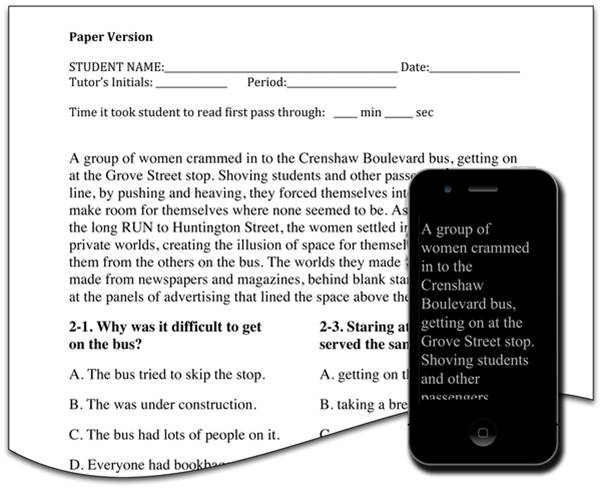Dyslexia Research News
E-Readers Trump Paper for Dyslexics in Boston Study
Less may be more when it comes to e-reading for dyslexics. Boston researchers have found that use of an e-reader significantly improved speed and comprehension for some dyslexic readers, when compared with traditional text on paper.

A sample of how the text was presented to the readers and the
comprehension questions that followed
In their study of 103 Boston area dyslexic students, researchers
compared reading performance on paper with that on an e-reader configured
to present just a few words per line (see iphone picture above).
Improvements were seen for students that previously experienced the most
difficulty sounding out words and using sight words.
But before running out to buy an I-Pad or Android tablet for your
child or student, keep in mind that the real story here is that the
improvement in reading is believed to have resulted from the reduction
in the number of words per line, not the change in medium. Further, only one third of the students showed a benefit - those who had a visual attention deficit. But that's still a very significant share of the students.
So the upshot is that while the E-reader itself is not the solution, the ease with which one can change the font size, line spacing and words per line on a phone, tablet or laptop may offer very tangible benefits to the dyslexic by virtue of it's flexibility. Magnifying glasses not required.
Challenge to Phonological Deficit Theory?
The most curious thing about the finding is that it implicates vision rather than hearing (auditory dyslexia). Most children with developmental dyslexia are believed to primarily have an auditory processing deficit that makes it difficult to manipulate the sounds (phonemes) of language. This study underlines the fact that visual attention span deficits also play a role.
Study Abstract (provided by the authors)
E-readers are fast rivaling print as a dominant method for reading. Because they offer accessibility options that are impossible in print, they are potentially beneficial for those with impairments, such as dyslexia. Yet, little is known about how the use of these devices influences reading in those who struggle.
Here, we observe reading comprehension and speed in 103 high school students with dyslexia. Reading on paper was compared with reading on a small handheld e-reader device, formatted to display few words per line.
We found that use of the device significantly improved speed and comprehension, when compared with traditional presentations on paper for specific subsets of these individuals: Those who struggled most with phoneme decoding or efficient sight word reading read more rapidly using the device, and those with limited visual attention spans gained in comprehension.
Prior eye tracking studies demonstrated that short lines facilitate reading in dyslexia, suggesting that it is the use of short lines (and not the device per se) that leads to the observed benefits.
We propose that these findings may be understood as a consequence of visual attention deficits, in some with dyslexia, that make it difficult to allocate attention to uncrowded text near fixation, as the gaze advances during reading. Short lines ameliorate this by guiding attention to the uncrowded span.
Title: E-Readers Are More
Effective than Paper for Some with Dyslexia
Researchers: Schneps MH,
Thomson JM, Chen C, Sonnert G, Pomplun M (2013)
Source: PloS ONE 8(9):
e75634.
doi:10.1371/journal.pone.0075634, September 18, 2013.
Link: Plos One Online Journal
Return to the top of Dyslexia News
- Home ›
- Dyslexia Research News